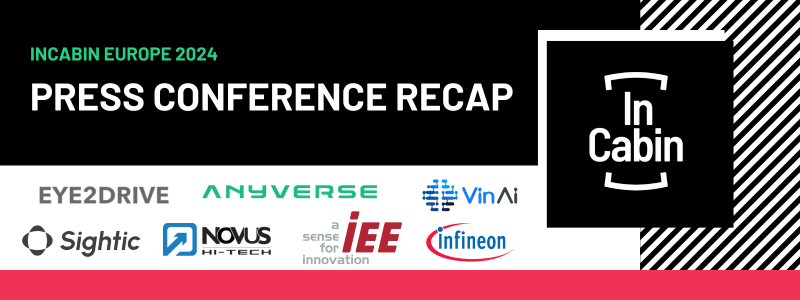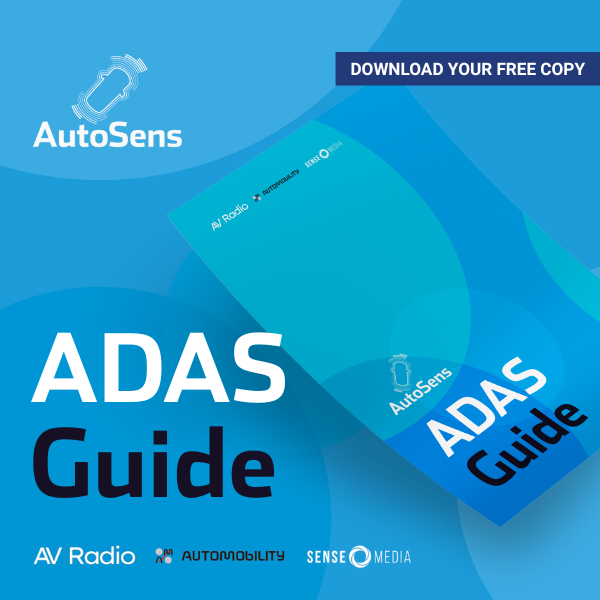
Following the top-tier USA conferences held in June 2024, the InCabin and AutoSens press briefings took place at the Palau de Congressos in Barcelona, Spain, during the week of October 8, 2024. The event brought together senior technical leaders from the automotive industry and Tier 1 suppliers to shape the future of ADAS and autonomous vehicle perception technology.
On Wednesday, October 9, a press conference was held where seven companies made significant announcements during the InCabin press briefing. Below is a comprehensive recap of what each company presented.
1. Anyverse
Anyverse, a leading provider of synthetic data solutions, utilized the InCabin Europe 2024 press briefing to launch its new Driver and Occupant Monitoring System validation framework, designed for supply chains, perception suppliers, integrators, and OEMs. This framework aims to accelerate system acceptance while enhancing safety and compliance.
According to the press release, to address inconsistent KPIs and complex protocols, Anyverse has introduced its high-fidelity simulation platform. This platform efficiently produces high-quality imagery with 3D environments, enabling OEMs to fine-tune their systems.
“The industry’s push for in-cabin monitoring systems is undeniable, but validation challenges have slowed down progress for too long,” said Víctor González, CEO of Anyverse. “Anyverse directly addresses these bottlenecks by providing quality validation-ready synthetic datasets and simulations tailored to comply with worldwide regulations and adapt to each system’s unique needs. We’re excited to help our partners streamline validation, overcome regulatory hurdles, and ultimately get safer in-cabin systems into vehicles more quickly.”
Key features of Anyverse’s new high-fidelity simulation engine include:
- Datasets tailored to specific client needs, governmental regulations, and vehicle models.
- Custom simulations of biomechanical gestures and behaviors of drivers and occupants, including facial expressions, child presence, drowsiness, or distraction.
- Simulation of in-cabin elements such as seat fabric, color, and material, using Anyverse’s DB or infrared cameras.
- Coverage of various environmental conditions with light variability, achieved through precise modeling of actual sensors to minimize the sim-to-real gap.
2. Eye2Drive
At InCabin Europe, Eye2Drive presented its image sensor technology, inspired by the human eye, which aims to revolutionize the functionality of sensors in the autonomous vehicle industry.
As announced at the event, this innovative image sensor can dynamically and continuously mimic the adaptability of the human eye to fluctuating lighting conditions, whether day or night—an area where standard market cameras often struggle with limited configurations in variable scenarios.
“We are excited to participate in InCabin Europe 2024, a key event for showcasing the latest technologies in cabin systems and autonomous navigation,” said Monica Vatteroni, CEO and co-founder of Eye2Drive. “Our sensors are designed to adapt dynamically to changing light conditions, offering a competitive edge in industries where precision and adaptability are paramount. This event will allow us to engage with potential partners, clients, and collaborators to further develop and integrate our technology into the rapidly evolving automotive landscape.”
This integrated vision sensor, along with its accompanying software solution, features:
- A compiled data sheet with precision based on the imagery produced.
- Immunity to flickering and the capability to offer a wide dynamic range, from low to very high.
3. IEE Sensing
IEE Sensing took full advantage of the Barcelona conference platform to showcase its comprehensive technical portfolio, celebrating the successful delivery of 500 in-cabin sensors. As presented by Alain Schumacher, CTO and Executive Committee member at IEE S.A., the wide range of sensors designed to enhance vehicle safety and occupant comfort includes:
- Seat Belt Reminder: An efficient system that encourages timely seatbelt fastening to reduce the risk of severe injuries.
- Hands-Off Detection: A sensing technology that monitors driver engagement by detecting hands on the steering wheel.
- VitaSense Child Presence Detection: A rear seat reminder that alerts parents about forgotten babies using vital sign detection.
- BodySense Occupant Classification: A smart sensor that classifies occupants by weight and size for precise airbag deployment.
- Driver Monitoring System: A complete in-cabin sensing solution tailored for Level 2 driver assistance and monitoring.
“Our achievements are a testament to our team’s dedication and our commitment to driving innovation in automotive safety,” says Paul Schockmel, CEO of IEE. “We are excited about the future and our role in shaping it with cutting-edge technologies that make roads safer for everyone.”
Additionally, IEE Sensing plans to integrate multiple sensors to enhance functionality and comfort through Sensor Fusion technology.
4. Infineon
Building on its predecessor’s Sensor Fusion technology, Infineon announced the development of the highly integrated IRS9103A vertical cavity surface emitting laser (VCSEL) driver IC for automotive applications. Enhancing Infineon’s REAL3 Time-of-Flight portfolio, this driver IC integrates a Low-Voltage Differential Signaling (LVDS) receiver, a VCSEL driver, and switching components, all managed in a 1.35-square-millimeter wafer-level package powered by a 3.3-volt domain.
“What is already standard in consumer electronics is now available for automotive Time-of-Flight (ToF) applications,” said Andreas Kopetz, Vice President Ambient Sensing at Infineon. “Instead of four discrete key components needed to drive the laser illumination source, only one is required. This greatly simplifies the design and minimizes the bill of materials and module size, while improving performance and robustness.”
Key advantages include:
- Smart and timely airbag deployment, along with smart restraint applications.
- Real-time measured 3D body models with accurate size and weight estimates.
- In combination with a 2D camera, this 3D data can validate AI algorithms.
- An optimized bill of materials with a simplified design and reduced development costs.
- Efficient conversion from electrical to optical modules.
5. Novus Hi-Tech Robotic Systemz Pvt Ltd.
Aiming for zero accidents, Novus Hi-Tech Robotic Systemz Pvt Ltd launched a full-stack, European Union General Safety Regulation (GSR)-compliant Advanced Driver Assistance Systems (ADAS) solution for commercial fleets. This integrated suite of in-cabin and exterior sensing technologies offers maximum protection to drivers, passengers, and pedestrians by utilizing real-time sensing data.
“Our mission is clear: empowering fleets to operate accident-free through an intelligent safety operating system,” said Anuj Kapuria, CEO and Founder of Novus Hi-Tech. “We believe that enriching human lives through smart technologies is key to ensuring a sustainable future. Our GSR-compliant ADAS solutions bring together advanced interior monitoring, such as driver alertness systems, and exterior sensing technology like blind spot detection, all designed to safeguard not just the driver but everyone on the road. We are excited to introduce these game-changing solutions to fleet operators across Europe at InCabin Barcelona.”
Variants and highlights of the GSR-compliant technologies include:
- Nova Safe, Nova Safe Pro, and Nova Safe 360: The three variants in the GSR suite.
- Nova Safe 360: The most advanced variant, featuring an A4 camera solution with four cameras—one forward, one backward, and two sideways. These cameras can be mounted on the steering wheel, interior rearview mirror (IRVM), dashboard, A-pillar, or windshield for occupant monitoring. It is an integrated sensor that combines the Moving Off Information System (MOIS), Blind Spot Information System (BSIS), Reversing Information System (REIS), Driver Drowsiness and Alertness Warning (DDAS), and Advanced Driver Distraction Warning (ADDW).
Tested on 10 million kilometers of Indian road data, these variants are trained for variable environmental and ethnic scenarios, making them highly compliant with ISO standards UN158 and UN159.
6. Sightic Analytics
Sightic Analytics announced the launch of the world’s largest naturalistic intoxicated driving data collection initiative in collaboration with a European OEM and a global Tier 1 supplier.
Snjezana Simic, Senior Vice President of Automotive at Sightic Analytics, and Stephanie Nyafi, Co-Founder of Sightic Analytics (with previous experience at the Swedish Police Department), co-presented the significance of this real-world data collection on intoxicated drivers. Aiming to accelerate the development of impairment detection technologies within ADAS, this dataset is expected to influence regulatory frameworks and insurance models while aligning with global road safety initiatives like Vision Zero and the UN Sustainable Development Goals—ultimately leading to a safer driving future.
Additionally, the presenters emphasized that this data collection complies with legislation regarding ethical consent and risk management while incorporating variability in gender, age, and ethnicity.
7. VinAI
At the InCabin press conference in Barcelona 2024, VinAI utilized a multi-sensor approach to introduce its two main products in the smart mobility division: the DrunkSense and InteriorSense product suite.
DrunkSense is the world’s first drunk driving detection system that combines facial expression tracking, vehicle control monitoring, and air alcohol sensors, eliminating the need for a breathalyzer. It provides an overall accuracy rate of 85%, which is 8% more efficient than currently available market products.
“DrunkSense was developed in the context of increasingly stringent regulations against drunk driving globally, especially in Europe and the US,” said Cap Thanh Vuong, Director of Smart
Mobility Products at VinAI. “Through DrunkSense, an advanced technology with automatic operation capabilities and superior accuracy, we hope to provide a safety solution for automakers in complying with strict standards, contributing to peace of mind for everyone when participating in traffic.”
The unique selling points (USPs) of DrunkSense over traditional breathalyzers include:
- It can issue pre-emptive alerts even when the driver’s blood alcohol concentration is below the legal limit.
- It is fully compliant with General Safety, Driver Drowsiness and Alertness Warning (DDAS), Advanced Driver Distraction Warning (ADDW), and NCAP standards.
- DrunkSense is compatible with high-performance GPUs like NVIDIA, Qualcomm, and Renesas.
Conclusion
Stay ahead of the curve in automotive innovation! Join over 10,000 engineers and specialists who receive the latest updates, insights, and discussions on ADAS and AV technology directly to their inbox. Don’t miss out! Subscribe to our newsletter today and be part of the conversation.



